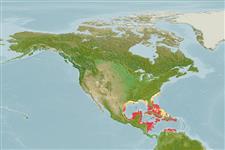分类 / Names
俗名 | 同种异名 | Catalog of Fishes(属, 种) | ITIS | CoL | WoRMS | Cloffa
Elasmobranchii
板鳃亚纲 (鲨鱼与 鱼) (sharks and rays) >
Myliobatiformes (Stingrays) >
Urotrygonidae (American round stingrays)
Etymology: Urobatis: Greek,oura = tail + Greek, batis, batidos = a ray (Raja sp.) (Ref. 45335).
More on author: Cuvier.
Environment: milieu / climate zone / depth range / distribution range
生态学
海洋 礁区鱼类; 深度上下限 1 - 25 m (Ref. 9710). 熱帶; 37°N - 7°N, 100°W - 59°W (Ref. 55316)
Western Atlantic: North Carolina, USA to northern South America. Also in Bahamas, Yucatan and throughout Caribbean (Ref. 26938).
西大西洋: 美國北卡羅萊那州到南美洲北部。 也在巴哈馬, 尤卡坦半島與在加勒比海各處.(參考文獻 26938)
大小 / 重量 / 年龄
Maturity: Lm ? range ? - ? cm
Max length : 76.0 cm TL 雄鱼/尚未辨别雌雄; (Ref. 9710)
简单描述
型态特徵 | 形态测量图
Edge of disk no sharp angles, no dorsal fin. Well-developed caudal fin extends around tip of tail, doubly serrate spine near caudal fin base (Ref. 26938). Disk yellowish, with dark vermiculations and spots that form a variety of patterns on upper surface (Ref. 7251). Lower surface is yellowish, greenish or brownish white, tail with dark spots (Ref.6902).
圆盘的边缘没有锐角, 没有背鳍。 发展良好的尾鳍延伸尾尖的周围, 在尾鳍基底附近的二倍锯齿状的棘.(参考文献 26938) 圆盘淡黄色的, 有深色的蠕虫爬迹形的装饰与斑点在上表皮上形成一个变异的样式.(参考文献 7251) 下表面是淡黄色的,呈绿色的或者白褐色的, 尾部有深色的斑点.(参考文献 6902)
Commonly found along sandy beaches to the water's edge, and especially in sandy areas in and around coral reefs (Ref. 7251). Raises front end of disc to attract prey seeking shelter (Ref. 7251). Feeds on shrimps, probably also on small fishes, clams, and worms (Ref. 12951). Known to be capable of inflicting dangerous wounds with its venomous spine. Easily approached (Ref. 9710). A live-bearing species, produces 3 to 4 young (Ref. 26938).
普遍地栖息于沿着沙滩到水的边缘, 与尤其在珊瑚礁的里面与周围的沙地中.(参考文献 7251) 举起体盘的前端吸引寻找庇护所的猎物.(参考文献 7251) 吃虾, 可能也捕食小鱼,蛤,与蠕虫.(参考文献 12951) 已知能够施放危险的创伤用它的有毒棘。 容易接近。 (参考文献 9710) 一个胎生或卵胎生种, 生产 3 到 4个幼鱼。 (参考文献 26938)
Life cycle and mating behavior
成熟度 | 繁殖 | 产卵场 | 卵 | 孕卵数 | 仔鱼
Male grasps disc margin of female, swings under her and inserts a clasper. Mating pair is surrounded by other males that swim around and nudge them. Dugger (1987) (Ref. 51118) observed both male and female biting the pectoral fin of its mate (Ref. 49562).西大西洋: 美國北卡羅萊那州到南美洲北部。 也在巴哈馬, 尤卡坦半島與在加勒比海各處.(參考文獻 26938)
Compagno, L.J.V., 1999. Checklist of living elasmobranchs. p. 471-498. In W.C. Hamlett (ed.) Sharks, skates, and rays: the biology of elasmobranch fishes. Johns Hopkins University Press, Maryland. (Ref. 35766)
人类利用
水族馆: 公众的水族馆
更多信息
年龄范围成长体长-体重体长-体长体长-频率形态测量图型态特徵仔鱼稚鱼动力学入添量丰度BRUVS
参考文献养殖养殖信息品种遗传学Electrophoreses遗传率疾病加工NutrientsMass conversion
合作者照片Stamps, Coins Misc.声音神经毒速度泳型鳃区Otoliths脑重体重比眼睛色素
工具
特别资料
下载 XML
网络资源
Estimates based on models
Preferred temperature (Ref.
123201): 25.8 - 28.1, mean 27.3 °C (based on 482 cells).
Phylogenetic diversity index (Ref.
82804): PD
50 = 0.5078 [Uniqueness, from 0.5 = low to 2.0 = high].
Bayesian length-weight: a=0.01072 (0.00570 - 0.02016), b=3.03 (2.86 - 3.20), in cm total length, based on LWR estimates for this species & (Sub)family-body (Ref.
93245).
营养阶层 (Ref.
69278): 3.6 ±0.51 se; based on food items.
回复力 (Ref.
120179): 非常低的, 最小族群倍增时间超过14 年 (Preliminary K or Fecundity.).
Fishing Vulnerability (Ref.
59153): Moderate to high vulnerability (50 of 100).
Nutrients (Ref.
124155): Calcium = 7.17 [0.77, 112.55] mg/100g; Iron = 0.376 [0.030, 3.868] mg/100g; Protein = 20.4 [15.0, 25.6] %; Omega3 = 0.069 [0.021, 0.205] g/100g; Selenium = 24.1 [4.1, 110.7] μg/100g; VitaminA = 47.1 [3.2, 591.0] μg/100g; Zinc = 0.963 [0.062, 10.956] mg/100g (wet weight);
